Hello 500 brothers and Cuồng are back with you after the recent trip to the Northwest region of Cuồng!!! And not to keep you waiting any longer, let’s start exploring the 15 scariest specialties of the Northwest with Cuồng.
Nậm Pịa
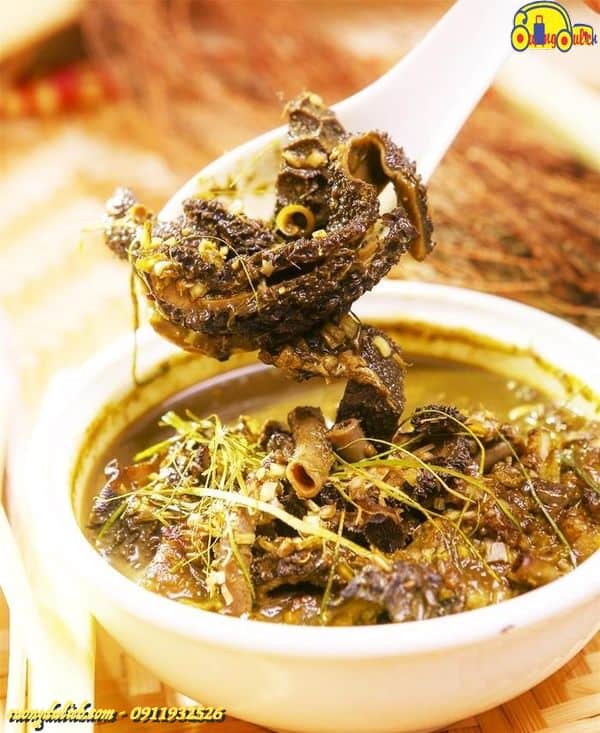
At the top of the list, we must mention the dish Nậm Pịa first. Nậm Pịa is a traditional delicacy of the Thai ethnic people in the highlands, often appearing at communal gatherings, festivals, or feasts. This is considered a specialty dish that you should try once when visiting the Northwest region. In Thai, “Nậm” means “soup” and “Pịa” is the surprising part. It is the slimy liquid in the intestines of grass-eating animals such as buffalo, cow, goat, or even more shockingly, it can include non-digested food or “non-feces.” Despite its gruesome components, Nậm Pịa has amazing health benefits and is known for its ability to cure hangovers. To make this Northwest dish, the ingredients include frozen blood, silver leaf, cartilage, tail, meat, and the five internal organs of grass-eating animals like cows, buffaloes, and goats, but usually people in the Northwest use beef and goat. It may sound normal, right! However, the main ingredient of this dish and what makes Nậm Pịa famous for its “creepiness” to the point that many people have to “close their eyes and hold their noses” to try it is the “Pịa.” The non-digested liquid is the most important component of the dish and is prepared very meticulously, but only the people in the highlands can do it. Initially, the best part of the non-digested intestine is selected, the Pịa is taken out into a bowl, then seasoned with unique spices like mac khen, lemongrass, chili, and added internal organs like heart, stomach, liver, lungs. Nậm Pịa is served in a bowl or small dish while still hot, accompanied by raw vegetables. This is not an easy dish to eat due to its bitter taste and strong smell. At first, you may find it hard to swallow because of the intestines, Pịa, the smell of mac khen, and bitter leaves added, but later it leaves a sweet, fatty taste in your throat. However, if you overlook the hesitations about the taste and smell, this is a wonderful dish, bringing together the culinary essence of the Northwest mountains and forests. So if you have the opportunity to travel to the Northwest, don’t forget to try Nậm Pịa, a Northwest dish of the Thai people!
Thắng Cố

In the second place is the dish called Thắng Cố. Thắng Cố can be found in any northern mountainous region, but in Lào Cai, it has a unique and exceptional taste that cannot be found anywhere else. The main reason is that it is made from the “six organs and five meats” of the horse, along with essential spices such as thảo quả, địa liền, hạt dổi, củ sả, quế chi… marinated with meat before stir-frying and then simmered in a large pan. With its distinctive and alluring flavor, the bubbling Thắng Cố pot on the red fire stove looks quite appealing with pieces of meat, light golden fat, white pieces of tripe adorned with fresh green onions emitting the fragrant aroma of meat and spices, warming the space amidst the cold weather. The bowl of Thắng Cố becomes even more captivating when enjoyed with Shan Lùng corn wine (Bát Xát), or Bản Phố corn wine (Bắc Hà) distilled from the unique yeast made from the mi hồng tree, which Cuồng guarantees will immerse you in the essence of the land and sky, carrying the unique flavor of Lào Cai cuisine.Thắng Cố may be more familiar to young people as it is quite common and can be found in some places in Hanoi or Saigon. However, due to being adapted for lowland people, this dish has been modified to make it easier for everyone to enjoy, losing the true taste of Thắng Cố. So if you have the opportunity to visit highland markets or ethnic festivals, you will have the chance to taste the authentic Thắng Cố dish. Some Northwest tourists, when they approach a pot of Thắng Cố, cannot bear its smell and have to run away, but those who are accustomed to this dish can easily become addicted to it. Making a bowl of Thắng Cố and savoring it with a bit of corn wine on a cold day in the highlands is truly delightful!!!
Stir-fried garlic chives
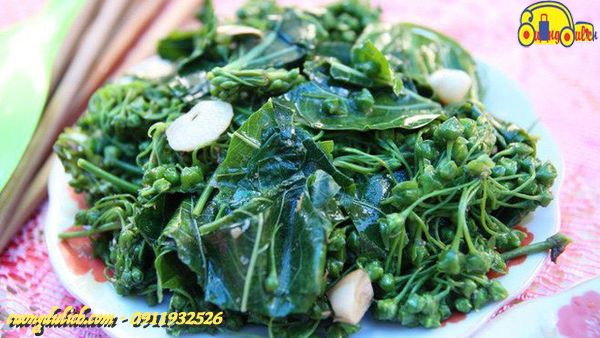
When you hear about “finger leaves,” surely everyone must shudder if they have to try this dish, right? Of course, it’s scary because “finger leaves” are particularly famous for being poisonous and potentially deadly, and for Cuồng, this dish ranks third in the top 19 most terrifying specialties of the Northwest. However, according to the locals here, this finger leaf can be completely edible and has a deliciously unique flavor. To distinguish it from the inedible finger leaves, this type is rounder and shorter. Because of its indescribably delicious flavors, the people here choose this dish as a specialty to treat guests from all over. Finger leaves can be prepared in many different dishes, but stir-fried finger leaves with garlic are the most common. It has a taste like other wild vegetables, but finger leaves are sweeter and more fragrant, especially when stir-fried with garlic and vegetable oil, making the leaves shiny and attractive. And that’s why this dish has become a “specialty” that cannot be found elsewhere. Moreover, the White Thai people in Mường So often use the leaves and flowers of this plant to boil, make soup, or stir-fry instead of wild vegetables. This dish has gradually become popular and familiar in the daily meals of the locals. Especially, their Tet feast is considered incomplete without finger leaves.
Roasted citrus leaf beetles
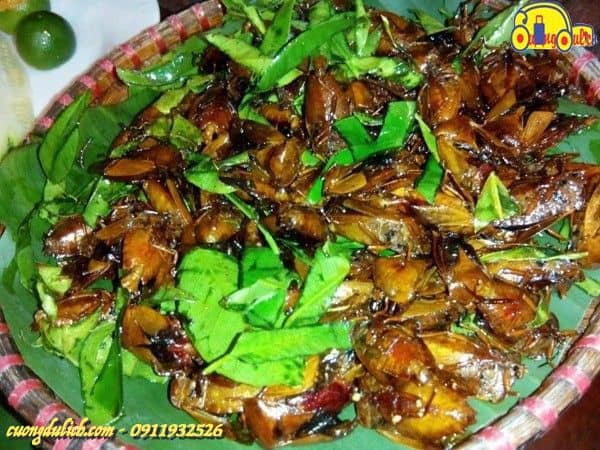
For many people, the stink bug is a smelly and scary insect, but for the Thai ethnic people in Son La province, it is an essential ingredient for many delicious dishes, among which the most famous is the stir-fried stink bug with lime leaves. The crispy texture and crunchy sound of the stink bug combined with the fragrant, spicy aroma of lime leaves make this dish a specialty that many people enjoy. To prepare this dish, the stink bugs must be young, without fully developed wings, and living on guava and longan trees. To catch the stink bugs, locals use small, thick-mesh nets to protect the flowers and fruits, then gently shake the branches with long poles, causing the bugs to fly up and fall to the ground. After catching them, the stink bugs are soaked in diluted saltwater until bubbles rise to the surface, indicating the removal of the smell. They are then cleaned, removing the head, wings, and intestines, before being fried in oil or lard. To achieve a crispy texture, they are fried in hot oil, on a large fire, and constantly stirred. Before serving, lime leaves are added without any additional spices, as the stink bugs themselves carry salty, spicy, and sweet flavors. The ideal stir-fried stink bug should be shiny and dark, with a sweet, rich taste on the tip of the tongue, and a crispy, fragrant texture. The people of Son La often enjoy this dish with hot rice or corn wine during family meals. For them, stir-fried stink bugs with lime leaves are a familiar, rustic, and nutritious dish. Every year during the longan flowering season, the people of Son La gather in the longan and guava forests to catch insects for consumption. Nowadays, this dish has become popular and is favored by many tourists whenever they visit the region.
Cháo ấu tẩu
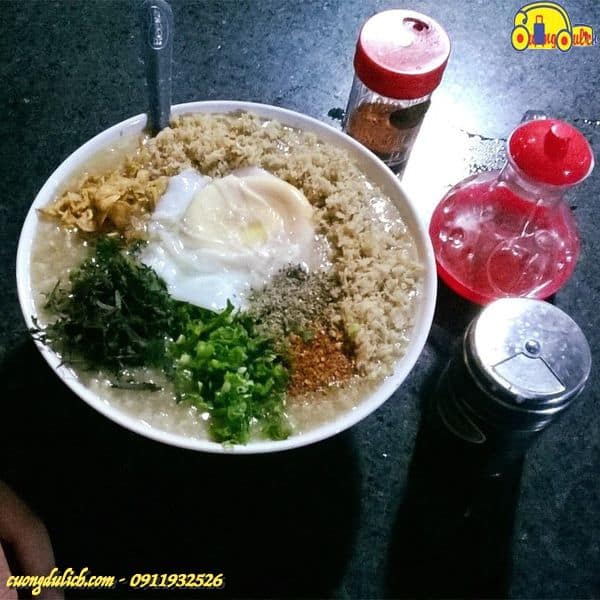
Cháo ấu tẩu in Ha Giang is made from a special ingredient called ấu tẩu root, which is a very toxic root. When you hear about it, everyone starts to panic, right? However, through the skillful processing by the people of the Northwest, it becomes a healthy dish. ấu tẩu root is usually found in the northern provinces of Vietnam. It looks similar to the ấu root from the south, but they are completely different. ấu tẩu root grows on rocks, is very hard and toxic. In traditional medicine, ấu tẩu has great healing properties, especially when soaked in medicinal alcohol for joint pain relief. According to the locals, consuming ấu tẩu root directly can be fatal. There have been cases of death from mistakenly drinking alcohol infused with ấu tẩu root. It is unknown when dishes made from ấu tẩu root became a unique feature of this region. The ấu tẩu root porridge is a distinctive dish whenever the rocky plateau of Ha Giang is mentioned. According to Mrs. Hương, a famous ấu tẩu root porridge shop owner in Ha Giang, there is a secret in processing this ingredient. Before cooking the porridge, the ấu tẩu root must be soaked in rice water, then simmered until soft, mashed, and cooked with plain rice, sticky rice, and pork leg. “ấu tẩu root is very hard, so after washing it, put it in the pot and simmer until it softens on its own. Due to its high toxicity, only a few roots are used in a large pot of porridge,” the experienced shop owner revealed. ấu tẩu root porridge is served with minced meat, various herbs, pepper, or sour bamboo shoots. Besides its rich and creamy taste, the porridge has a slightly bitter and unique flavor. For travelers who have traveled a long way to Ha Giang, eating a bowl of ấu tẩu root porridge will refresh their bodies, make them healthier, more alert, and enthusiastic. ấu tẩu root porridge is available all year round, but the interesting thing is that it is only sold in the evening. According to the shop owner, having porridge in the evening is most effective for a good night’s sleep. The dish helps relax muscles and bones, reduce joint pain, and restore energy. Nowadays, ấu tẩu root porridge has spread throughout the country, not just in the North. For many people, porridge is not just a filling meal, but also a very good health benefit.
Rotten meat guarding the kitchen
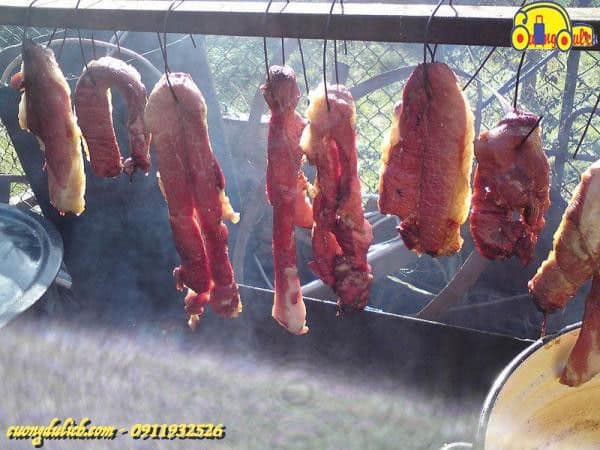
This is considered the most “horrifying” dish due to the way the Khơ Mú people prepare it. Spoiled meat is used from pork, buffalo, or beef. This meat is then sun-dried. However, it is not seasoned and is left to dry for about 7-10 days. During the drying process, water is sprinkled on the meat along with the unseasoned part, which will make them emit a smell to attract insects. And they believe that the more spoiled and worm-infested the meat is, the more attractive this dish becomes.However, this dish is still loved by many people and some even become addicted to it once they get used to it. When visiting this place, if you have the desire to taste this specialty dish, you will be served this dish right away.
Spoiled Vegetables
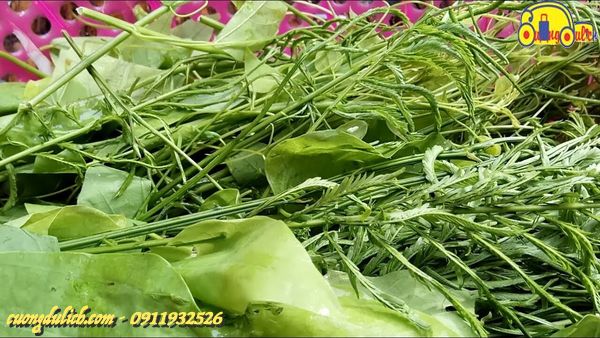
In addition to spoiled meat, Son La is also famous for the unique “spoiled vegetable”. This is a type of climbing plant with dark green symmetrical leaves. The plant stem and branches have many sharp thorns. It is called spoiled vegetable because of its strong foul smell, which can be detected even from a distance. The spoiled vegetable grows wild in the forests. The plant stems grow long, wrapping around any nearby trees. The young tender leaves reach up high, collecting pure dew drops and the golden morning sun rays of the Northwest land. The Thai people process the spoiled vegetable into various dishes such as soup, stir-fry, or salad. With a simple cooking style, the Thai people often combine the vegetable with buffalo meat, pork, or fresh fish caught from the stream. Sometimes just a little fragrant fried shallot oil and quickly stir-frying the fresh green vegetable can make the meal exceptionally appealing. The slightly bitter taste, combined with a hint of strong aroma lingering in the throat, is enough to make anyone who loves highland specialties salivate. Many people often compare the spoiled vegetable to durian fruit. The strong foul smell of both can be intimidating and unpleasant for first-time tasters, but once acquired, it can become addictive, leaving a lasting impression. Both spoiled meat and spoiled vegetable are considered two famous dishes, commonly used in the meals of the ethnic people in Son La. If you have the opportunity to travel here, do not forget to taste and experience the unique cuisine of the Northwest land.
Bamboo Worms
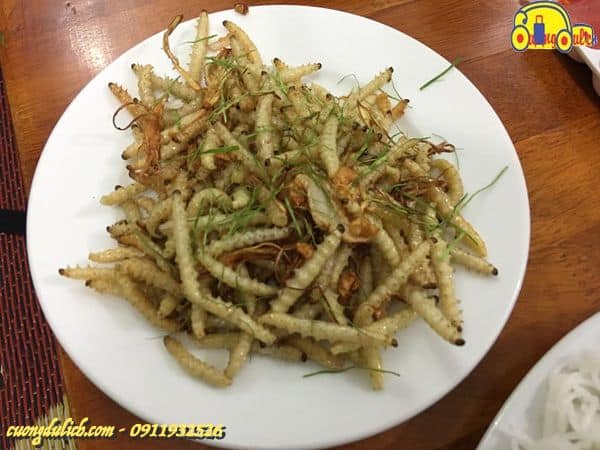
Bamboo worm is a famous and rare specialty of the Northwest, even those with money may not be able to buy it. Just as its name suggests, bamboo worm is a type of larvae that lives inside bamboo joints. It is whitish, about the length of two finger joints. Bamboo worm has a high protein content, rich in nutrients, good for health. Bamboo plants infested with bamboo worms often show signs of withering, the bamboo joints become shriveled and abnormally short. The bamboo worm season starts from September and lasts until the end of October. Bamboo worms thrive and become plump during this time. Bamboo worms have high protein and amino acid content, and can be processed into various dishes such as crispy fried with lime leaves or grilled bamboo worms, crispy and fatty in taste. To catch bamboo worms, forest-goers use a knife to cut across the bamboo tube to check. If they find worms inside, they will widen the bamboo tube hole and catch them by hand. Each nest can contain up to half a kilogram of living worms. Due to its high nutritional value and rich flavor, many people seek to buy bamboo worms to eat. However, the supply is insufficient, leading to a high price for this specialty dish, around 500,000 VND/kg of bamboo worms. However, this specialty dish can also cause allergies and may be toxic to some people with incompatible constitutions, so everyone should consider carefully before trying this dish.
Grilled Moss
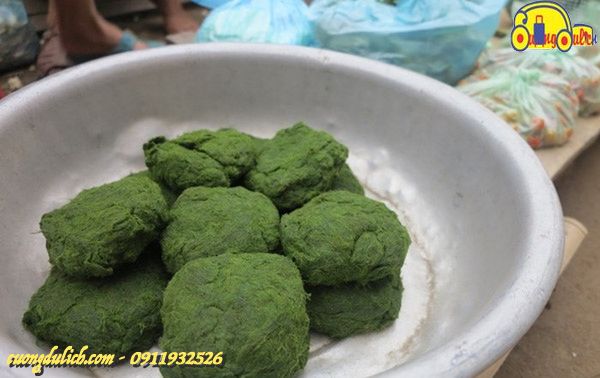
The Thai people have many delicious dishes such as bamboo-cooked rice, buffalo meat cooked on a stove, and bitter vegetables… But there is a rustic specialty that few people know about, which is the stone moss dish in the Northwest. Mentioning the type of moss growing on rocks, no one would think that this could be a specialty of the Thai ethnic group, right? However, stone moss is a specialty found only in the Northwest region, moss usually clings to the edges of rocks in the stream. Stone moss grows seasonally starting from spring and summer, good moss is long and delicate, feels cool and smooth to the touch, just gently pick it up with your hand. Stone moss can be processed into many delicious dishes, the simplest of which is fresh moss soup or also known as “kinh tau”. After removing all the sand, the moss is cut into small pieces, put into boiled chicken or bone broth, seasoned just right, when cooked, it will release an attractive aroma. Stone moss is a gift from the land and sky for the Thai people, this dish is not widely known and almost not consumed in other regions. If you want to eat stone moss, you can only enjoy it in the Northwest regions because the quantity of stone moss is limited, it cannot be preserved for long and is only enough for Thai families to consume. However, you should also prepare yourself before tasting it because at first glance, stone moss looks quite similar to Pía or a pet’s furball.
Pía cá
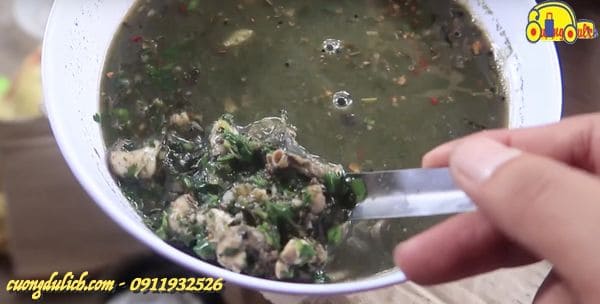
Alongside popular dishes like pía bò and pía dê that leave diners “spellbound,” few know that in this region there is also a very impressive dish called pía cá. Similar to many other pía dishes, pía cá is made from the intestines of fish, combined with the characteristic spices of the Northwest. Unlike other bitter pía dishes, pía cá has a soft, sweet taste from the fish intestines and the unique spices, especially the prominent aroma of lemongrass and galangal that overpower the initial fishy smell, leaving diners lingering. According to Ms. Điện, an experienced chef in cooking pía cá, she shares: “Pía cá is quite easy to eat, not as “horrifying” as other types like pía dê, pía trâu because the fish intestines have been cleaned.” And surely, on the first few tries, tourists may be a bit startled by the Sơn La pía dish. However, after a few bites, you may become “addicted” and unable to forget its distinctive flavor.
Jumping fish dish

Jumping fish is considered a popular dish, a specialty of the Thai people in Son La. The dish may look simple but is very selective in terms of who can enjoy it. The unique aspect of this dish lies in the unusual way it is eaten, with the fish still jumping in the mouth when consumed. The Northwest region is not only famous for its majestic natural landscapes but also for its rich and diverse cuisine. One of the famous dishes that cannot be missed when traveling here is the “jumping fish” of the Thai people in Son La. The dish is simple but very selective in terms of who can enjoy it. The distinctive feature of this dish is the unusual way it is eaten: the fish must still be alive, prepared and eaten right at the table. The fish used to make the “jumping fish” dish must be raised in natural ponds or caught in mountain springs, far from residential areas. The fish caught must still be alive, selecting small fish, with the largest size being equal to an adult’s thumb, releasing them into a basin of clean saltwater to allow the fish to swim and expel any impurities from their bodies. Then, the fish is rinsed again with light saltwater to meet the requirements. According to the Thai people in Son La, the best type of fish to make jumping fish is baby carp. Many families are meticulous, waiting until the rice planting season, which is when the carp start laying eggs. They take the carp eggs clinging to water hyacinth flowers and release them into the fields. When the rice plants flower, the rice flowers fall into the water, and the fish only eat those rice flowers, making them very clean. When the rice is in full bloom, people catch the fish in the fields and bring them back to prepare the jumping fish dish.The most outstanding feature of this dish is the accompanying spices. The fish is served with fresh banana core, aromatic herbs (coriander, mint, basil, Vietnamese balm…), various condiments like fish sauce, salt, MSG, garlic, chili, and especially the essential Sichuan pepper (a special spice of the Thai people). Everything must be finely chopped to create a mixture with sour, spicy, savory, sweet, and distinctive aromatic flavors. When eating, people usually catch the fish from the basin, quickly make a small incision in the fish’s belly with a knife, squeeze out the intestines, and then quickly release it into the accompanying mixture. Each person uses a small spoon to scoop up the fish along with the banana core and sour water to taste. For those who have never tried jumping fish, this is indeed a strange dish, very difficult to imagine the taste. Furthermore, not many people dare to put a piece of live fish into their mouths for immediate enjoyment. However, discerning diners will immediately recognize the unique taste on the tip of their tongue, which is the crispy, sweet taste of the fish meat and the spicy taste of garlic, chili, the tingling sensation on the tongue, and the strong aroma of Sichuan pepper. The spices will mask the fishy taste, leaving only the sweet, crispy, fragrant, and slightly bitter taste of the meat along with the accompanying herbs. To prepare this dish, one of the key principles to note is that the fish must be clean and naturally raised. When gutting the fish, it must be done quickly so that the fish is still alive and can still jump. Jumping fish is quite popular in Thai families in Son La, especially when hosting special guests. If you ever get the chance to travel here, you must try this dish to experience the essence and diversity of the cuisine and culture of the Northwestern highlands.
Rotting buffalo skin
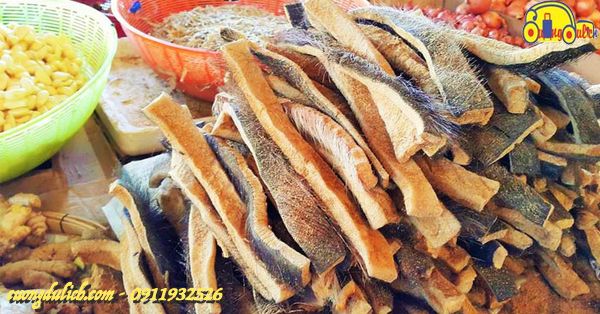
Buffalo skin or “nang min,” a characteristic dish of the Thai people. The skin of the buffalo, after being filtered, still retains the hair, wrapped in banana leaves, and fermented for about two days. In the summer, high temperatures can make the buffalo skin “rot” faster, while in winter, with low temperatures, it needs to be fermented for more days before processing. After a period of fermentation, the buffalo skin smells, and after washing it clean, the hair will fall off. Then, the skin is dried, and can be used to make soup, banana flower salad, or grilled according to preference. For the local people, this is a specialty with a distinctive delicious taste. However, for many people from other regions, just hearing the name of the dish and smelling it, they may have to think twice before deciding to taste it. Besides fermented buffalo skin, people from the highlands of Northwest Vietnam are also famous for buffalo skin hanging over the kitchen. Through the skillful hands of the ethnic people, the tough buffalo skin becomes crispy, flavorful, and delicious. To make a delicious dish from buffalo skin hanging over the kitchen is truly a laborious process. The buffalo skin is soaked in water for many hours until soft, then cut into small pieces. Next, the buffalo skin is marinated with spices such as chili, lemongrass, salt, seasoning powder, and mac khen, then processed into soup or buffalo skin salad, salted buffalo skin, etc.
Water Beetle
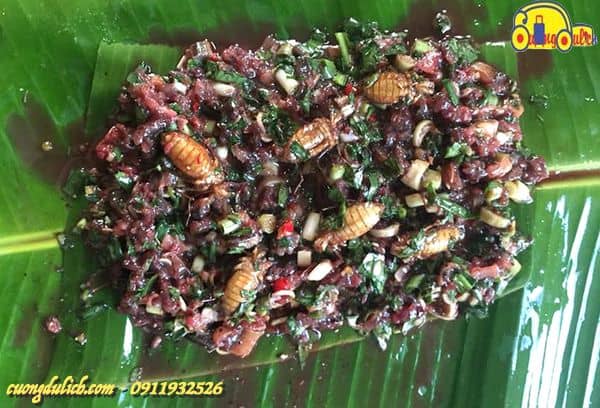
Water beetles (dragonfly larvae) are not always available. Water beetles are caught in rivers and streams around the Dien Bien area in March and April. The beetles clean their legs, mince them, add spices, forest pepper, and herbs such as basil, perilla, scallions, coriander, mint, and chili, wrap them in banana leaves, then bury them in red hot charcoal for about 40 minutes. When cooked, this dish has a fragrant taste of herbs and forest pepper, with a chewy, slightly crunchy texture.
Muồm muỗm rang
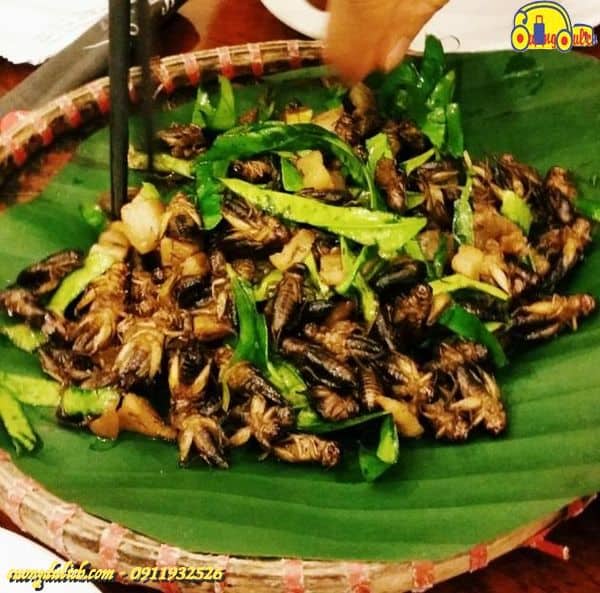
When mentioning the land of Yen Bai, many people immediately think of famous places like Mu Cang Chai and Thac Ba Lake. However, Yen Bai is also very famous for many delicious dishes that become attractive specialties for visitors from near and far. And one of those specialties is the dish called Muồm muỗm rang Mường Lò. However, to enjoy Muồm muỗm rang Mường Lò, it needs to go through a processing stage. The head, wings, legs, and intestines of the Muồm muỗm need to be removed. Many people comment that after processing, Muồm muỗm looks no different from silkworm cocoons. Then the Muồm muỗm is washed and put into a pan. First, the Muồm muỗm is simmered with sour bamboo shoots or rice vinegar on a low flame. It is simmered until the water evaporates, then lard or cooking oil is added and stirred evenly over high heat. It is roasted until it crackles, indicating that the Muồm muỗm is cooked. Seasonings and a little fresh chili are added and quickly stirred. Then lime leaves are added and stirred for a while before removing from the pan. The cooked Muồm muỗm has a dark yellow color and is especially fragrant. Muồm muỗm rang Mường Lò is a rustic dish, familiar in the daily meals of the local people and has become a famous specialty that visitors should not miss when setting foot in this land.
Nhộng ong đất
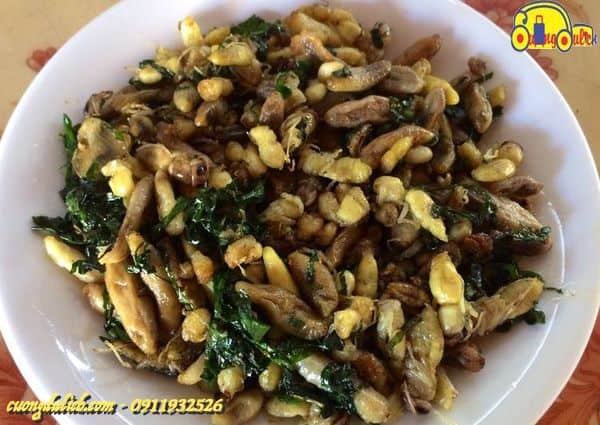
Bee larvae (also known as bee pupae) is a rare specialty food of the people in the Northwest, because the bee breeding season is only from April to September, however, it is not easy to obtain natural bee pupae.Visiting the Northwest in late August or early September, you will immerse yourself in the gentle afternoon sun shining down on the villages, fields. Feel the coolness of the transitional season, the hospitality of the people here, and if you are lucky, you will have the opportunity to enjoy the specialty of Northwest bee pupae, a special dish that you cannot always enjoy. Unlike silkworm pupae commonly sold nowadays that are easily extracted from the cocoon, to obtain natural bee pupae, the people of the Northwest have to use very manual and dangerous methods. For example: using a long stick to knock down the bee hive, courageously wearing thick clothing, a raincoat covering the body, and manually removing the bee hive. Burning the bee hive is the most common method used.Using fire to burn the bee hive helps to collect the intact bee hive. To ensure safety, people use leaves or bundled sticks tied tightly to the end of a tree branch, a long stick, then ignite the fire and bring it close to the bee hive. The bee colony will fly away when encountering the heat and smoke. At that time, people quickly approach to collect the intact bee hive before the bees return to the hive. Even when extracting bee pupae from the hive, one must be extremely careful and vigilant, as in many cases, adult bees from the hive may fly out and sting if not careful. After extracting all the bee pupae from the hive, it is necessary to process the dishes immediately to ensure freshness, as if left in the outside environment, the bee pupae will spoil quickly. If the silkworm pupae are yellow, large, and evenly round, the wild bee pupae are white, milky white, or slightly yellowish, with the sizes of the bee pupae usually not uniform. The people of the Northwest process bee pupae into unique dishes: fried bee pupae with lime leaves, marinated bee pupae grilled in bamboo tubes, marinated bee pupae wrapped in turmeric leaves and grilled, bee pupae rolled in betel leaves, however, the most common is bee pupae stir-fried with sour bamboo shoots and lime leaves or turmeric. The delicious, rich taste of bee pupae, combined with the sourness and crunchiness of carefully soaked bamboo shoots, along with the fragrant aroma of lime leaves, makes it unforgettable for anyone who has tasted it. If you have the opportunity to visit the Northwest from April to September, at the latest in October, do not miss this special dish.
Electric shock caterpillar in Dien Bien

These are insects that live inside the trunk of the chit tree. To know which tree has chit worms, harvesters will choose trees with signs of disease, unable to bloom (these are trees that have been parasitized by larvae). Locals catch chit worms by “splitting” the chit stems in half to extract the worms. The fresh chit worms are milky white, plump, and after being removed, they are usually released in a light wine pot. This wine will prevent the worms from deteriorating. Besides the most common use of soaking in wine, chit worms can also be dried, or cooked in porridge. Research data shows that the “caterpillar fungus” species has a protein content of 25-32% in the body, including 6 amino acids, while chit worms have an equivalent protein content but the identified amino acid composition is up to 17 out of 20 types needed for the body. Therefore, in Dien Bien and other Northwestern regions, chit worm wine and chit worm meat are popular items consumed by visitors from other regions.
